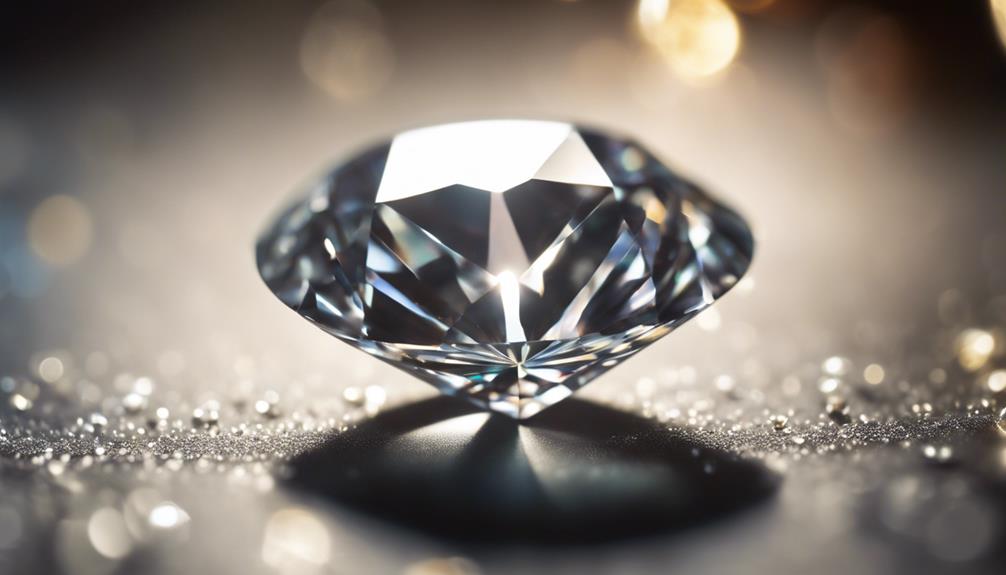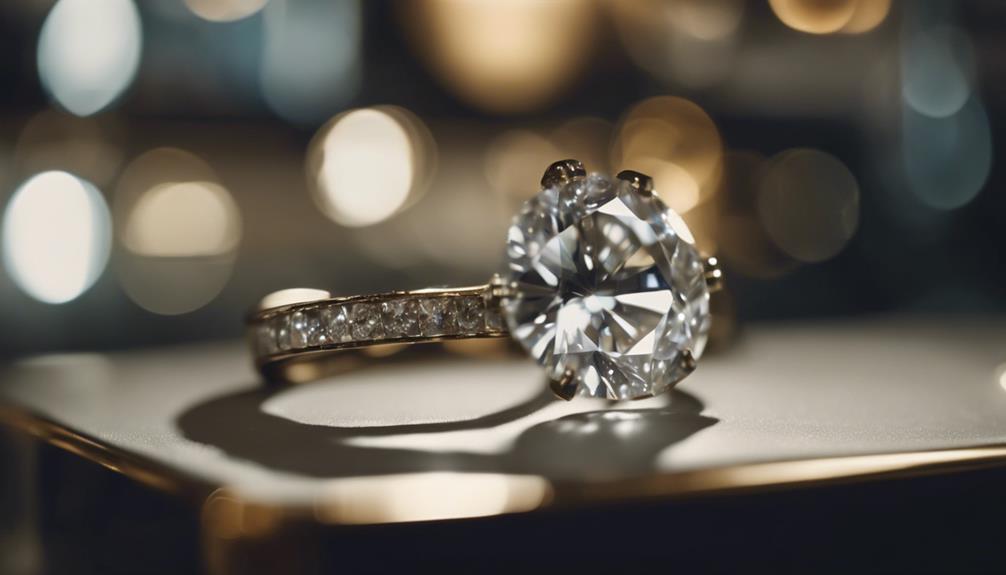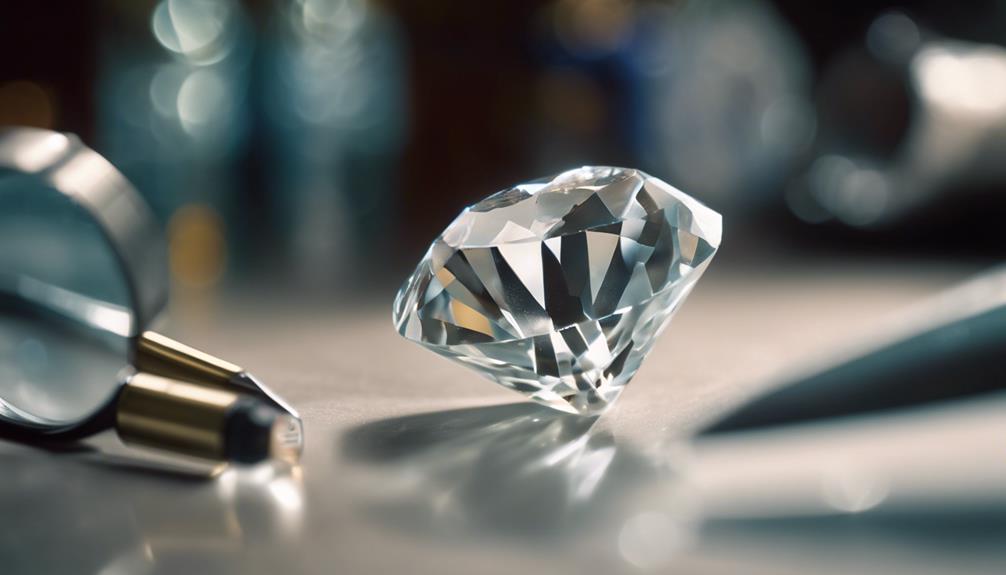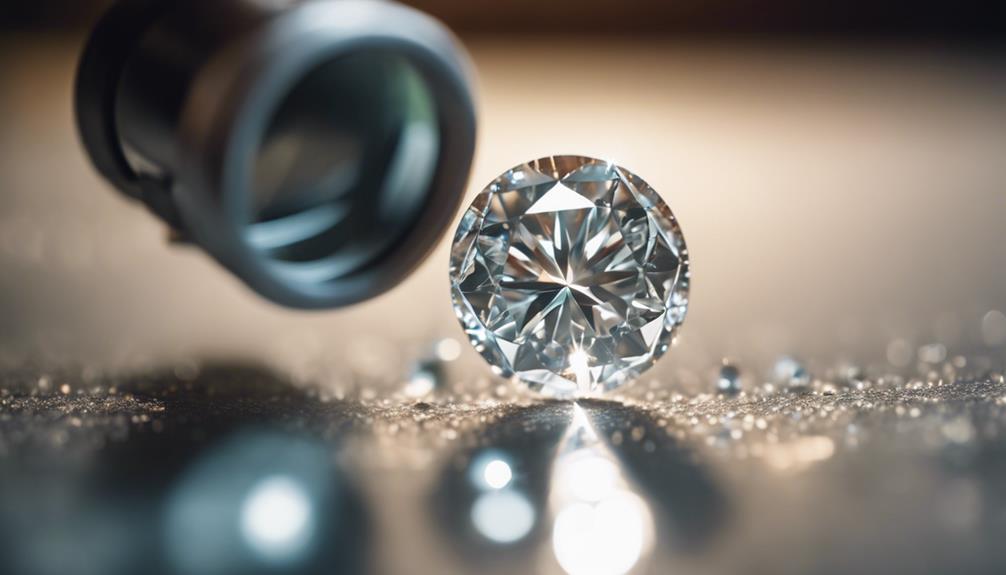Understanding diamond clarity helps you make an informed purchase. Clarity measures imperfections, called inclusions and blemishes, affecting a diamond’s value and beauty. The GIA grades clarity from Included (I) to Flawless (FL). Many inclusions aren’t visible without magnification, so you can find eye-clean diamonds in the VS2 to SI2 range, which offer great value. Be mindful that round cuts hide inclusions better than step cuts. Knowing clarity can help you balance aesthetics and cost. For a deeper grasp of how clarity affects your choice, let’s explore more tips and insights.
Importance of Diamond Clarity

When you’re buying a diamond, understanding its clarity is crucial because it directly affects both the beauty and value of the stone. Clarity grades assess a diamond’s imperfections, known as inclusions and blemishes. These tiny flaws can influence how light travels through the diamond, impacting its sparkle and brilliance. Higher clarity grades signify fewer inclusions, which generally means a more beautiful and valuable diamond.
However, clarity isn’t just about having a flawless stone. Many inclusions are microscopic and invisible to the naked eye, so you mightn’t need a perfect clarity grade to get a stunning diamond. Knowing the range of clarity grades, from Flawless (no inclusions) to Included (visible inclusions), helps you make an informed decision.
Balancing clarity with other factors like cut, color, and carat weight can optimize both the visual appeal and value of your purchase. Ultimately, understanding diamond clarity allows you to prioritize what’s most important to you. If you’re aiming for maximum sparkle without overspending, you might find that a diamond with minor, non-visible inclusions offers the best balance.
Knowledge of clarity guarantees you get the most for your investment.
GIA Clarity Scale
The GIA clarity scale is the industry standard for evaluating and grading diamond clarity, helping you understand the quality of the stone. This scale ranges from Included (I) to Flawless (FL), providing a thorough assessment of a diamond’s internal and external characteristics. Grading involves examining diamonds under 10x magnification to identify inclusions and blemishes.
At the top of the scale, Flawless (FL) diamonds have no visible inclusions or blemishes, even under magnification. Next, Internally Flawless (IF) diamonds have no internal flaws but may have minor surface blemishes.
Very Very Small Inclusions (VVS1 and VVS2) show inclusions that are extremely difficult to see, even under magnification. Very Small Inclusions (VS1 and VS2) contain minor inclusions that are slightly easier to detect.
Slightly Included (SI1 and SI2) diamonds have inclusions that are more noticeable under magnification and sometimes visible to the naked eye. Finally, Included (I1, I2, and I3) diamonds have obvious inclusions that can affect transparency and brilliance.
Understanding the GIA clarity scale helps you make informed decisions, ensuring you get the best value and beauty from your diamond.
Eye-Cleanliness and Buying Tips

An eye-clean diamond appears flawless to the naked eye, making it a smart choice for those prioritizing visual appeal without the need for a top clarity grade. When you’re shopping for a diamond, focus on finding one that looks flawless without magnification. This approach guarantees you get a beautiful diamond without paying extra for a higher clarity grade that you won’t visually appreciate.
Look for diamonds in the VS2 to SI2 range. These often appear eye-clean and offer excellent value for their price. Inspect diamonds in various lighting conditions to spot any inclusions that might be visible. Remember, a diamond that looks perfect in one light might reveal flaws in another.
Don’t overpay for higher clarity grades like Flawless (FL) or Very Very Slightly Included (VVS) if eye-clean options at lower grades are available. A VS1 diamond can look identical to an SI2 diamond to the naked eye, making it essential to trust what you see.
Round cuts tend to hide inclusions better than step cuts like Emerald or Asscher, which require higher clarity (VS2 or better). By focusing on eye-cleanliness, you can find a stunning diamond that meets your aesthetic and budget.
Inclusions and Grading Factors
Understanding eye-cleanliness helps you make smart purchases, but knowing the types and impacts of inclusions is equally important. Inclusions are internal imperfections formed under extreme heat and pressure, and they play an essential role in diamond grading. By examining diamonds at 10x magnification, experts evaluate five key factors: size, nature, number, location, and relief of inclusions.
Common inclusions include clouds, graining, cavities, and feathers. Clouds are clusters of tiny pinpoints that can make a diamond appear dull. Graining results from irregular growth lines, causing a hazy look. Cavities are surface dents or cracks with visible color variations, while feathers are small cracks with a feathery appearance that may reflect light.
The location and size of these inclusions greatly impact a diamond’s clarity grade. Inclusions near the center are more noticeable and can lower the grade, while smaller inclusions at the edges may have less impact.
Understanding these grading factors helps you make informed decisions, ensuring you get the best value for your budget. Always consider these inclusions when evaluating diamonds to balance beauty and cost effectively.
Additional Considerations and Resources

When choosing a diamond, consider how clarity affects value and appearance, and take advantage of resources to make an informed decision. Clarity is just one part of the equation, but knowing how it impacts both beauty and cost will help you get the most for your money. Clarity grades may seem complex, but focusing on eye-clean diamonds can simplify your search.
To further educate yourself, tap into reputable online retailers that offer detailed descriptions, high-quality images, and expert evaluations. Websites like The Diamond Pro provide extensive guides and videos that explain clarity and other essential factors, allowing you to see diamonds up-close before making a purchase.
Don’t forget to explore FAQs on these sites. Common questions often address how inclusions affect value, differences between natural and synthetic diamonds, and why cut influences sparkle more than clarity. These insights can clarify your priorities when choosing a diamond.
Conclusion
By now, you should feel confident in choosing a diamond that perfectly balances clarity, beauty, and value.
Remember, the highest clarity grade isn’t always necessary; many inclusions are invisible to the naked eye. Use the GIA clarity scale as your guide, but focus on eye-cleanliness and personal preferences.
With these tips and insights, you’re now equipped to make an informed, satisfying diamond purchase. Enjoy the journey and trust your judgment!



